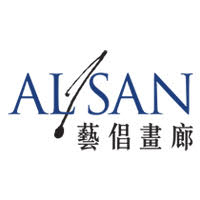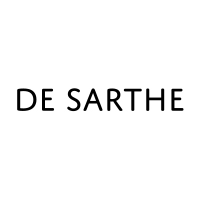Contemplating at Ease—Solo Exhibition of BAISHUI
By Chun Art Museum
Presented by Chun Art Museum*
Installation view of BAISHUI’s "Contemplating at Ease" at Chun Art Museum, 2025.
Artist: BAISHUI
Curator: Zhang Zikang
Organizer: Chun Art Museum
Co-organizer: RONG Art Space
The solo exhibition of artist BAISHUI will be held from March 30, 2025 to April 29, 2025 at Chun Art Museum in Shanghai, curated by Zhang Zikang.
Born in the canal town of Jiangnan (areas south of the Yangtze River), BAISHUI’s artistic creation always carries the deep thinking and emotional projection of water. In Chinese culture, water has been regarded as the beginning of everything in the universe since ancient times, and it symbolizes flexibility, fluidity, and the endless cycle of life. In BAISHUI’s works, it is easy to find the concepts of Confucianism, Buddhism, and Taoism, which are the classics of traditional Chinese philosophy.
Confucianism, represented by Confucius, has formed the historical viewpoint of using flowing water as a reference in its way of realizing flowing water, and using water as a mirror to look back at itself. For example, the Raindrop series of works in this exhibition not only expresses the various forms of rainwater, but also enlarges the scale of raindrops, making the viewer re-examine the greatness of nature and the insignificance of human beings. This way of thinking embodies the spiritual pursuit of Confucianism’s “unity of universe and mankind”, reminding us that in the midst of modern technology and urbanization, we should not forget our close connection with nature.

BAISHUI, Ocean 18, acrylic on canvas, mixed media, 50 × 60 cm, 2024.
The philosophical thinking of Taoism, represented by Laozhuang, on “water” mostly comes from “still water”. BAISHUI's series of works such as Spring Water and Raindrop show the fluidity, inclusiveness and eternity of the vastness of the flow in the Ocean series, it all maps out the cosmic concept of “being in harmony with nature” in Taoist thought.
In Zen philosophy, water is a symbol of life, and cultivation is the process of using “pure water” to wash away the dust in people’s mind. The clarity of the water symbolizes the practitioner’s pure heart, and if the heart is free of distractions, the practitioner will be able to gain insight into his or her nature and see the reality of the world. Zen aesthetics pursues an artistic style of emptiness, nothingness, and simplicity, emphasizing white space and the viewer’s spiritual participation.

BAISHUI, Quantum Roses 1, ink on canvas, mixed media, 200 × 150cm, 2024.
In works such as Spring Water and Raindrop, BAISHUI utilizes Zen-like expressions, such as simplifying figurative forms, so that the viewer can imagine and feel in the imagery of the work. Her works often do not intentionally provide a single understanding, but rather allow the viewer to experience the aesthetics of “something out of nothing” and “meaning beyond words” in the process of viewing.
Whether “mirror water”, “still water” or “pure water” are inseparable from people’s reflection on themselves, just as the artistic expression of BAISHUI, not the beauty of the appearance, but a deeper spiritual level of touching and philosophizing.
Installation view of BAISHUI’s "Contemplating at Ease" at Chun Art Museum, 2025.
Installation view of BAISHUI’s "Contemplating at Ease" at Chun Art Museum, 2025.
Artist BAISHUI integrates nature, technology and culture with her unique artistic language, enabling the audience to feel the rhythm of life in the flow of color and light and shadow, and to think about the relationship between human and nature, human and technology, and human and self in the space where reality and falsehood are intertwined. BAISHUI’s works, for example Spring Water combine the elegance of traditional Chinese color system with the light and shadow layers of Western aesthetics, and the emphasis on the changes of light and shadow in Western paintings, so that the picture has the dense feeling of oriental ink and wash, but also presents the gorgeous texture of digital paintings. She utilizes the digital screen to interact with light and shadow, allowing the viewer to feel the swaying of the water waves, in a way that is reminiscent of the flowing landscape imagery in the Northern Song Dynasty painter Fan Kuan’s Traveling Among Mountains and Streams, as well as echoing the Western Impressionists’ study of light. The flow of light and shadow approach gives her works both the subtle beauty of the East and the expressive logic of Western visual art, demonstrating a cross-cultural fusion.

BAISHUI, Shimmer 9, acrylic on canvas, mixed media, 200 × 200 cm, 2025.
Although BAISHUI’s works utilize a lot of abstract and technological elements, their roots are still in the natural world. Through visual images, data analysis, installation art, and other techniques, she reproduces the various forms of water. This reproduction is not only a copy of the physical world, but also a symbolic expression refined through artistic means, which resonates with the viewer and even triggers an emotional purification experience during the viewing process.
This exhibition not only showcases BAISHUI’s deep sense of nature, but also uses art as a medium to convey thoughts about human existence. Her works encourage viewers to return to nature and re-examine the relationship between human and nature, human and technology. Just as water flows everywhere, BAISHUI’s art is inclusive and free, transcending regions and cultures, mapping the deeper philosophical reflections of mankind, and flowing into the future.

Portrait of BAISHUI.
About the Artist
BAISHUI, currently residing in Shanghai, Hong Kong (China). A visual and installation artist, 2025 Forbes China Emerging Artist.
BAISHUI infuses art with a vivacious creativity, transforming profound contemplation into profoundly experiential and engaging artistic works, continually shaping an innovative, exploratory, and avant-garde style. Through a fusion of hand-drawing and AI digital painting techniques, collage methods, and the innovative use of synthetic materials, she creates distinctive easel paintings. She remains vigilant against losing sensitivity and depth to natural aesthetics in the drive for technologically propelled artistic innovation. This methodology not only presents her creations with visual originality but also underscores the ongoing fusion of Eastern and Western cultures and the significance of innovation, showcasing the potential for a new natural aesthetic.
The artistic practice of BAISHUI is deeply rooted in the exploration of the humanistic, natural, and technological landscapes, aiming to explore the interaction between visual experience and the natural and cultural landscapes. Her works emphasize the texture of water and the symbolic and spiritual value of natural landscapes in human daily life. Currently, BAISHUI is dedicated to researching the New Naturalism, primarily through material transformation, multi-layered narratives, and multidimensional views of the universe in her creations. BAISHUI’s research projects delve deeply into the constructive aspects of material culture related to nature, particularly in how the integration of modern technology and Eastern cultural philosophy can make material memory and natural narratives symbolic systems of information transmission. Her research framework employs a variety of materials and creative modes, executing a comprehensive cross-contextual and cross-cultural fusion, providing rich narrative space for contemporary aesthetics.






